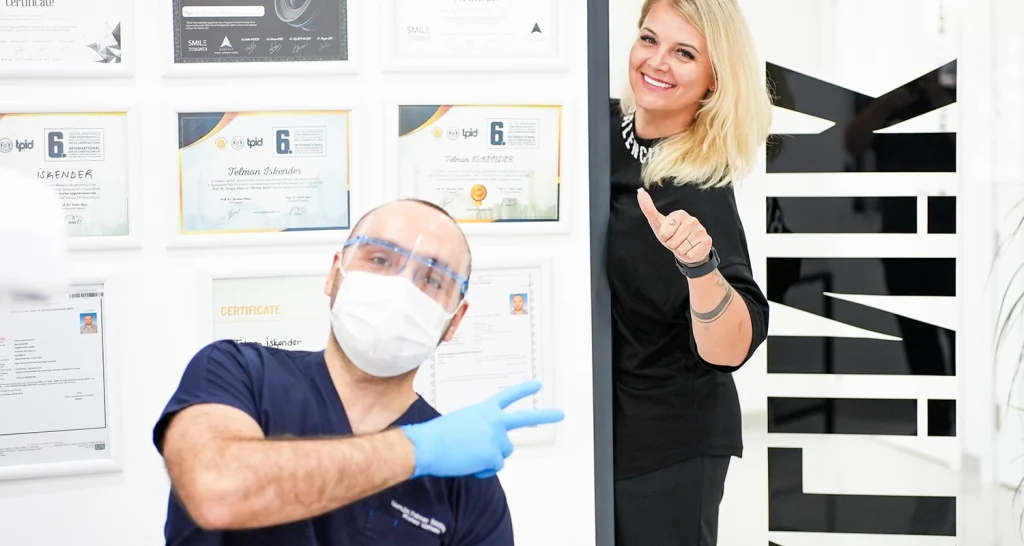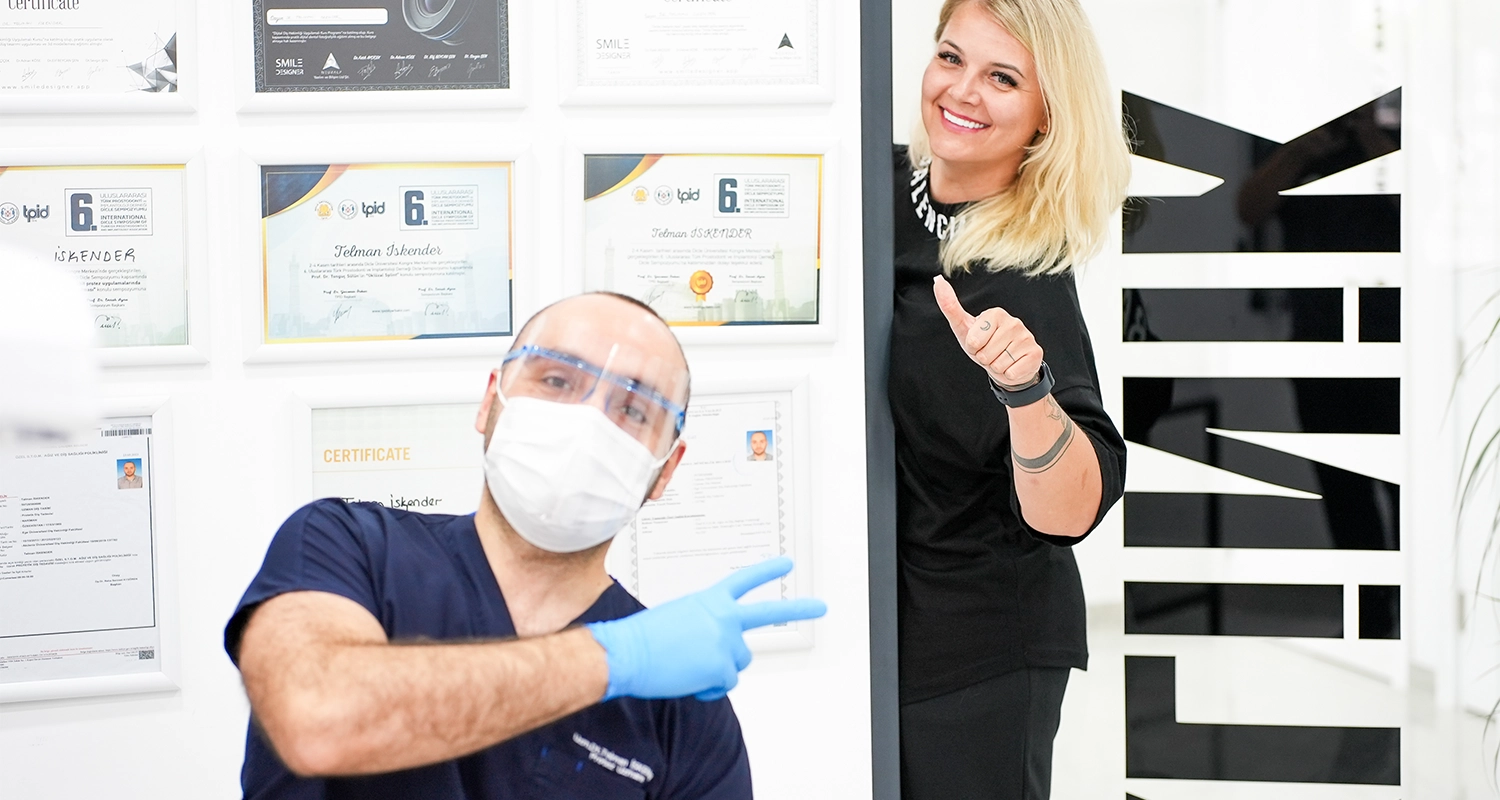Jaw Structure Deformation
Aesthetic and Functional Solutions
Jaw structure deformation are among the complex conditions that can have significant effects on smile aesthetics and masticatory functions of individuals. Under this title, the general definition of jaw deformities, their types and their potential aesthetic and functional effects will be examined in detail.

What are Jaw Deformation?
Jaw deformation refer to abnormalities in the shape, size or position of the jaw structure. The lower jaw may be in a forward or backward position, the jaw joint may be malformed and asymmetry of the facial skeleton may occur. In this section, the general definition and common types of jaw deformities will be explained.
Effects of Jaw Structure Deformation
Aesthetic and Functional Factors
Aesthetic Effects
Facial symmetry, abnormalities in the position of the lower jaw can negatively affect smile aesthetics.
Correction of jaw deformities can provide aesthetic improvement.
Functional Effects
Disorders in the jaw joint can affect chewing functions.
Correct jaw position can improve speech and chewing functions.
Causes and Risk Factors of Deformation
Jaw structure deformities can occur due to various causes. In this section, common causes and risk factors of jaw deformities will be examined in detail.
Genetic Factors
- Role of Family History and Genetic Predisposition
Jaw deformation may indicate that genetic predisposition is effective in the presence of similar conditions in the family. Genetic factors inherited from parents play an important role in the formation of the jaw structure. Certain genetic mutations or disorders can affect the development of the jaw, which can lead to the appearance of deformities.
Traumas
- Accidents and Impacts Affecting the Jaw Structure
The jaw is a sensitive part of the facial area and accidents or blows can cause changes in the jaw structure. Particularly severe blows to the facial area can lead to fractures of the jaw bone or damage to the jaw joint. Such traumatic events can contribute to the development of jaw deformities.
Congenital Anomalies
- Developmental Anomalies in the Prenatal Period
Some jaw deformation can be caused by developmental anomalies in the prenatal period. Abnormalities that occur during development in the womb can cause the jaw bones not to form correctly and lead to deformities. These conditions usually require early diagnosis and intervention.
Risk Factors
- Age
Some jaw deformation may occur with age or existing deformities may become more pronounced with age.
- Gender
Some jaw deformation are more common in certain gender groups.
- Environmental Factors
Environmental factors can affect jaw development, especially during childhood. Nutrition, jaw use and environmental conditions may play a role in the formation of deformities.
- Tooth Problems
Dental crowding or missing teeth can affect the jaw structure and cause deformities.
Understanding the complex interplay of these factors in the formation of jaw deformities is important for accurate diagnosis and treatment planning. A detailed evaluation by a specialised dentist or surgeon is a critical step in understanding the individual’s specific condition.
Pre-Operational Assessment and Preparation
Preoperative assessment and preparation stages are critical for dealing with jaw structure deformities. In this section, we will focus on the details of these stages.
Examination and Imaging
- Detailed Examination
A detailed examination is carried out to accurately assess jaw deformities. The dentist or surgeon assesses the current state of the jaw structure, the function of the joints and the overall structure of the facial skeleton.
- Digital Imaging Techniques
Modern technology has made this assessment more precise with digital imaging techniques. Computed tomography (CT), 3D imaging and digital models provide a detailed analysis of the jaw structure.
Assessment of the General Health Status of the Patient
- Importance of General Health Status Before Operation
Jaw surgery can have an effect on general health status. The general health status of the patient is evaluated before the operation. The patient’s blood pressure, heart rhythm, allergies, medication use and other health factors are taken into consideration.
Patient Information and Expectations
- Communication with Patient
Open and effective communication with the patient is the basis of a successful treatment. Before surgery, the patient is informed about the details of the process, possible risks and expected results.
- Setting Expectations
Patient expectations are important for the success of the treatment. Surgical results are determined in accordance with personal preferences and aesthetic goals. It is important to set realistic expectations to maximise patient satisfaction.
These stages are critical steps that affect the pre-operative preparation process for jaw deformities. A detailed evaluation allows the creation of a personalised surgical plan and increases the chances of success of the treatment.
Surgical Solutions and Techniques
Surgical solutions and techniques used in the treatment of jaw structure deformities include the advantages offered by modern medicine and technology. In this section, detailed information about open and closed sinus lifting, bone augmentation and advanced surgical techniques will be given.
Open and Closed Sinus Lifting
Advantages of Sinus Lifting Methods
- Open Sinus Lifting
The sinus cavity is widened and the implant placement area is prepared.
It offers an effective solution for large bone deficiencies.
It can increase implant success.
- Closed Sinus Lifting
It is a minimally invasive method.
It can provide faster recovery after the operation.
It is suitable for cases where bone loss is minimal.
Sinus lifting is an effective technique used in implant surgery to increase bone volume and improve implant stability. The advantages of both methods are evaluated depending on the patient’s condition and the degree of bone deficiency.
Bone Grafting
Techniques for Correcting Bone Deficiencies
- Autogenous Bone Graft
The patient’s own bone tissue is used.
It is a natural material with a high success rate.
- Allogeneous Bone Graft
Bone tissue from another donor is used.
Immunological compatibility must be taken into account.
- Synthetic Bone Graft
Bone-like materials produced in the laboratory environment are used.
Immunological compatibility is not a problem.
Bone augmentation is a series of techniques used to increase jaw bone volume and support the implant placement process. Each type of graft is selected according to the patient’s condition and treatment needs.

Advanced Surgical Techniques and Modern Solutions
State-of-the-Art Solutions such as Robotic Surgery, 3D Printer Technology
- Robotic Surgery
Provides precise and controllable surgical interventions.
Used in microsurgery and complex operations.
- 3D Printer Technology
It is used in the production of specially designed implants and prostheses.
It offers sensitive and personalised solutions.
State-of-the-art solutions such as advanced surgical techniques, robotic surgery and 3D printing technology allow for more precise, effective and personalised interventions in the treatment of jaw deformities. These technologies can help patients achieve faster recovery processes and optimised treatment outcomes.
Postoperative Care and Recovery
After surgical interventions related to jaw structure deformities, a careful care and follow-up process is necessary for patients to have a healthy recovery process and achieve successful results.
Recovery Process and Controls
Situations that the patient may encounter in the postoperative period:
- Pain and Swelling
Mild pain and swelling from the surgical intervention is normal.
Painkillers and cold applications prescribed by the doctor can help.
- Food and Diet
It may be recommended to eat soft foods for a certain period of time after surgery.
The patient should support recovery by watching his/her diet.
- Stitches and Healing
Control and removal of sutures ensures a healthy healing of the surgical site.
Hygiene rules must be observed and recommended care instructions must be followed.
Post-Surgical Follow-up Process
- Controls
Scheduled check-ups at regular intervals after surgery allow the doctor to assess recovery.
Bone healing is monitored using X-rays and imaging methods.
- Evaluation of the Recovery Process
The patient should share the recovery process with his/her doctor.
Any complications or problems can be detected early and treated.
Smile Aesthetics and Functional Improvement
The Effect of Correction of Jaw Deformities
- Smile Aesthetics
Jaw deformities corrected after surgery positively affect smile aesthetics.
Regular and symmetrical teeth provide an aesthetic smile.
- Functional Improvement
Correction of jaw deformities positively affects chewing, speech and other oral functions.
Functional improvement can improve the patient’s quality of life.
Patient Satisfaction and Sustainability of Results
Patients’ Satisfaction After Surgery
- Monitoring and Feedback
Patients’ postoperative experience should be followed up regularly.
Feedback should be utilised to improve service quality.
- The Importance of Long-Term Results
Regular check-ups are important for the sustainability of successful surgical results.
If necessary, additional treatments or revision surgeries can be planned.
The postoperative care and recovery process must be carefully managed to increase patient satisfaction and ensure long-term success. Good postoperative care ensures that patients recover in a healthy manner and fulfil their aesthetic and functional expectations.
Steps for a Healthy and Aesthetic Jaw Structure
Our service for jaw structure deformities offers a comprehensive solution for patients who want to achieve a healthy and aesthetic jaw structure. These steps are the details that form the basis of our service:
Preoperative Evaluation
A detailed communication and examination process with the patient allows the creation of the most appropriate treatment plan specific to the type of deformity.
Surgical Solutions and Techniques
Modern solutions such as open and closed sinus lifting, bone augmentation and advanced surgical techniques are methods that effectively correct deficiencies in the jaw structure.
Recovery and Controls
In the postoperative period, a healthy recovery period and follow-up with controls increase the success of the treatment.
Smile Aesthetics and Functional Improvement
Correction of jaw deformities improves smile aesthetics, while at the same time positively affecting oral functions.
Patient Satisfaction and Sustainable Results
Regular controls and communication are of great importance for the satisfaction of patients after surgery and the sustainability of long-term results.
The combination of these steps offers a comprehensive treatment for patients who want to achieve a healthy and aesthetic jaw structure. With modern technology, our experienced team and personalised treatment plans, it is now more effective and safe to deal with jaw structure deformities. Contact us to achieve a healthy smile and an aesthetic jaw structure.

